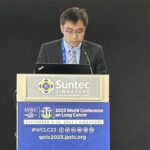The 2023 World Conference on Lung Cancer (WCLC), organized by the International Association for the Study of Lung Cancer (IASLC), was held in Singapore from September 9th to 12th. ” Oncology Frontier” invited Zhu Zhengfei from Fudan University-affiliated Cancer Hospital to comment on the findings of the COSINR study.
OA22.03 – The Addition of Multisite SBRT to Ipilimumab and Nivolumab in First Line Metastatic NSCLC: The COSINR Trial
Background
Checkmate 227 established ipilimumab and nivolumab (ipi/nivo) as a first line treatment option for stage IV non-small cell lung cancer (NSCLC), providing a median overall survival of 17.1 months. Stereotactic body radiotherapy (SBRT) provides high rates of metastasis control and may be additive to immunotherapy by providing direct cytoreduction and preventing early progression at existing sites of disease, leading to durable improved outcomes. We designed a phase I study to examine the safety and efficacy of SBRT and ipi/nivo in first line treatment of metastatic NSCLC.
Methods
Treatment naïve patients (ECOG 0-1) received SBRT to 1 to 4 isocenters. Not all metastases were targeted, and lesions >65 cc were partially irradiated. Brain metastases were allowed on protocol and those > 3mm were treated prior to enrollment. SBRT dose varied by anatomic site and ranged from 30 to 50 Gy in 3 to 5 fractions. Patients received cycle 1 of ipilimumab and nivolumab concurrently with SBRT or up to 7 days after completion of radiotherapy. Immunotherapy continued for up to two years or until progression. Treatment past progression was allowed per clinical discretion.
Results
Of 97 patients screened, 75 were enrolled on trial and received SBRT and at least one cycle of immunotherapy (median age 65; 55% male, 45% female). Histologies included adenocarcinoma (n=55, 73%), squamous cell carcinoma (n=13, 17%), and “other” NSCLC (n=7, 9%). Dose-limiting toxicity (all grade 3 pneumonitis events) occurred in 4 patients (5.3%). PD-L1 expression was 0% in 35 patients (46.7%), 1-49% in 24 patients (32%), ≥50% in 14 patients (18.7%) and unknown in 2 patients (2.7%). Brain metastasis was present in 24 patients (32%) and liver metastasis in 12 patients (16%).
72 patients had one imaging follow-up and were evaluated for response. Best objective response was as follows: 4 complete response (5.6%), 35 partial response (48.6%), 9 stable disease (12.5%), and 24 with progressive disease (33.3%) yielding an objective response rate of 54.2% and disease control rate of 66.7%.
Median progression-free survival was 5.7 months (95% CI 4.4 months – 11 months). Median overall survival (OS) was 34 months (95% CI 17 – 42 months). PFS did not differ by liver metastasis (p=0.761) or brain metastasis status (p=0.240). Median PFS was higher with PD-L1 status ≥1% (11 months vs 4.1 months, p=0.008). Objective response rate was 67.5% with PD-L1 status ≥1% compared with 36.7% in those with negative PD-L1 expression (p = 0.042). Median overall survival by PD-L1 status was 38 months vs 16 months (p=0.097).
Only one patient had first progression solely in an irradiated metastasis. 8 patients (16%) had first progression only at existing baseline non-irradiated disease. 40 patients (81.6%) progressed with new intracranial or extracranial metastases.
Conclusion
Multisite SBRT plus dual checkpoint immunotherapy blockade was well tolerated in first line treatment of widely metastatic NSCLC. In a population enriched for negative PDL1 expression, overall outcomes were encouraging with a median OS of 34 months. Further prospective study is warranted; radiomic and plasma correlative analysis is planned to help guide selection.
Dr. Zhu Zhengfei’s Commentary
The synergistic interaction between radiation therapy and immunotherapy has been demonstrated in many preclinical experiments. Clinically, two randomized phase III clinical trials have shown significant survival benefits for locally advanced NSCLC patients who received immune consolidation therapy in addition to conventional chemoradiotherapy. Compared to traditional radiotherapy, SBRT has the advantages of a smaller radiation field, higher single dose, and good protection of normal tissues. Many theoretical and preclinical studies have suggested that SBRT in combination with immunotherapy has greater promise. Recently, a randomized phase II clinical trial conducted by Dr. Zhang Yujiao from the MD Anderson Cancer Center in the United States, published in the Lancet Oncology in 2022, also suggested this. The study aimed to compare the efficacy of SBRT combined with immunotherapy (PD-1 antibody, Nivolumab) versus SBRT alone in early-stage primary or isolated lung parenchymal recurrence with lymph node-negative NSCLC patients. The results showed that the combination group significantly improved the 4-year event-free survival rate of patients, and the toxicity was tolerable.
There have been reports of exploratory studies in advanced NSCLC using radiation therapy in combination with immunotherapy. Overall, the sample sizes of these studies are relatively small, and most of the studies involve PD-(L)1 antibody drugs, with most studies utilizing SBRT for single lesions. The COSINR study reported at WCLC this year has two main characteristics compared to previous studies: (1) it combines therapy with two immune checkpoint inhibitors, namely, Ipilimumab (CTLA-4 antibody) and Nivolumab (PD-1 antibody); (2) it permits SBRT at 1-4 central sites rather than only treating a solitary lesion.
The COSINR study enrolled a total of 75 patients, and its preliminary results, as described in its conclusion, suggest that multisite SBRT combined with dual immune checkpoint inhibitors is well tolerated as first-line treatment for NSCLC. In the population with a relatively high proportion of PD-L1-negative expression, the OS results are encouraging, with a median OS of 34 months.
Previous research on the combination of radiation therapy and immunotherapy for advanced NSCLC has been reported in 2022 using dual immune drugs (CTLA-4 antibody Tremelimumab + PD-L1 antibody Durvalumab), and the results did not show any advantage over SBRT alone (Lancet Oncol. 2022;23(2):279-291). Both of these studies had small sample sizes, differences in enrolled patients, variations in drug treatments, and differences in radiation therapy between single and multiple lesions, which could account for the inconsistent research conclusions. However, the encouraging OS results from COSINR suggest the feasibility of further prospective studies for validation.

Dr. Zhu Zhengfei
Chief Physician, Director of the Radiation Therapy Center
Fudan University Shanghai Cancer Center


